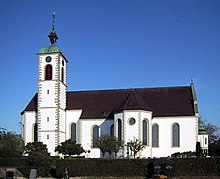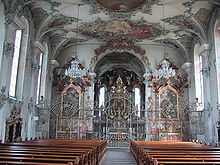Kreuzlingen Monastery
The Kreuzlingen monastery was founded around 1125 by the Bishop of Constance Ulrich I. von Kyburg-Dillingen as an Augustinian canon monastery in Egelshofen (today part of the city of Kreuzlingen ). In 1848 the Thurgau government abolished the monastery and moved the goods in. Worth seeing is the baroque appointed former monastery church of St. Ulrich and St. Afra.
prehistory
From 935 to 976, Konrad I , the saint, was bishop in Constance . He brought back a cross particle from one of his three trips to Jerusalem, which he donated to a hospital he had donated in the suburb of Stadelhofen. This is why it was given the name Crucelin (Crucis Lignum = wood from the cross), which later led to the names Crucelingen and Creuzlingen. After Konrad's death, however, the hospital soon seems to have fallen into disrepair. In the biography of St. Konrad, the “Vita Konradi”, the monk Udalschalk describes it as “dilapidated through age”. In a document from Emperor Heinrich V from 1125, the hospital is even described as "partially destroyed" and the negligence of some of the successors of Bishop Konrad is held responsible.
Ulrich I von Kyburg-Dillingen was Bishop of Constance from 1111 to 1127 and renewed the weakened Kreuzlinger Foundation around 1125. He founded a canon monastery on the eastern border of the suburb of Stadelhofen according to the rule of St. Augustine in honor of St. Ulrich, Bishop of Augsburg, and St. Afra, as one of the first Augustinian monasteries. Bishop Ulrich was a nobleman from Dillingen from the same family as St. Ulrich , Bishop of Augsburg (923–973).
The first monastery building
In 1144 Pope Lucius II and in 1145 Emperor Friedrich Barbarossa took the monastery under their protection. This led to the fact that the Kreuzlingen monastery became an imperial monastery and the abbots called themselves “prelates of the Holy Roman Empire” until the fall of the first empire. In the small rule of Hirschlatt north of Friedrichshafen they were sovereigns, this was also the place of refuge in times of war. The first monastery was built outside the suburbs with the construction of a city wall, which was supposed to protect Stadelhofen from the Appenzell people. At the time of the Council of Constance (1414–1418) from October 27th to 28th, 1414, the Kreuzlingen abbot Erhard Dominik Lind hosted the later deposed Pope Johannes XXIII . The Pope gave the abbot a splendid inful . Damita received this and his successors the right to wear " pontifical insignia " (including a miter , bishop's ring and shepherd's staff ) during mass . The golden Frauenfeld miter that was then made is exhibited today in Schloss Frauenfeld .
The second monastery building
In the Swabian War of 1499, Egelshofen also became a theater of war. After hard fighting, the Swabians had to retreat to Constance, and peace was reached at Basel , with the Confederates being awarded the district court and full sovereignty in Thurgau on October 15, 1499, following the arbitration of the Duke of Milan . Out of anger at this outcome and loss, the people of Constance attacked the monastery soon after and burned it down. Konstanz was then obliged to rebuild the destroyed monastery. On April 17, 1509, Abbot Peter I von Babenberg (1497–1545) was able to rededicate the church.
The third monastery building
During the Thirty Years' War in August 1633 Swedish troops, disregarding the neutrality of the Confederates, reached Egelshofen via Stein am Rhein in Thurgau and besieged the city of Constance in vain, losing several thousand men in the process. After they left Egelshofen on October 2, the Konstanzers destroyed the monastery a second time, on the grounds that it had served as a base for the Swedes . Now it was decided that the monastery could no longer be rebuilt immediately before Constance, but one cannon shot further away. The foundation stone was laid on July 4, 1650 and the church was consecrated on October 25, 1653.
The Church of St. Ulrich and St. Afra was built according to the plans of Michael Beer from Vorarlberg , the founder of the Auer Guild, between 1650 and 1653 by the Constance city architect Stephan Gunertsreiner and stonemason Melchior Gruber. The Mount of Olives Chapel was built in 1760, four years later the church and parts of the monastery were redesigned in the Rococo style .
The ceiling paintings by Franz Ludwig Herrmann show scenes from the religious life of St. Augustine . The splendid choir grille was made by Johann Jakob Hoffner in 1737. The larger than life statues of the church patrons St. Ulrich and St. Afra were created by Hans Christoph Schenk . The Mount of Olives Chapel with the Cross and Calvary is particularly worth seeing . The Mount of Olives designed by Innozenz Beck from pieces of beech into a grotto is enlivened by 250 original, approximately 30 cm high statues made of pine wood, they date from the years 1720 to 1730 and were carved in a workshop in the south-east of the Alps. The ceiling painting shows Moses with the brazen serpent and is also by Franz Ludwig Herrmann (1761).
Secularization and further use
In 1848 the government of the Canton of Thurgau abolished the monastery, confiscated all of its goods and sold them on. The medieval library was taken over by the Thurgau Cantonal Library . The street-side southwest wing of the monastery with the rococo library and some chapels were demolished. A teachers' seminar from the Canton of Thurgau, the forerunner of the Pedagogical Matura School in Kreuzlingen , moved into the remaining monastery complex . The monastery church St. Ulrich and St. Afra was taken over by the local Roman Catholic parish as the parish church.
In 1962/63 the parish church was extensively renovated. Shortly before it was completed, welding work in the attic of the teachers' college caused a major fire on July 19-20, 1963, which destroyed both the church and the monastery buildings. Only the surrounding walls, the bars, the vaulted ceiling in the choir, the choir stalls and a large part of the wooden figures in the Mount of Olives chapel survived the fire. Thanks to the great efforts of the monument conservator Albert Knoepfli and the dean Alfons Gmür, the church and the monastery buildings were faithfully reconstructed between 1963 and 1967 under the direction of Hans Burkard.
Since 1993 there has been a small museum with objects from the former Kreuzlingen monastery on the top floor above the sacristy of the parish church of St. Ulrich and St. Afra. The great fire of 1963 and the subsequent reconstruction are also documented. The Catholic parish office of Ortisei grants admission by appointment.
Bells
There are seven bells in today's high tower of St. Ulrich and St. Afra. It is the heaviest ring from the manufacturer Eschmann from Rickenbach in Thurgau. The full bell can be heard every Saturday when Sunday rings in. The big bell is silent on normal Sundays. It is the largest bell in Eschmann's company history. For some time now, all the bells have been ringing at weddings. In the tower lantern there is also a seventh small bell by Emil Eschmann in the tone e ''. It is only rung as a soloist. The mood of the six big bells is: G ° B ° d 'f' g 'b'.
Augustine as a Doctor of the Church, by Franz Ludwig Herrmann
Abbots
The head of the convent was the abbot (derived from late Latin: abbas, from Hebrew: abba father). He was responsible for both the pastoral and the secular direction of the monastery.
| Surname | Born | Died | Term of office | Remarks |
|---|---|---|---|---|
| Erhard Dominik Lind | 1428 | 1390-1423 | Received from the later deposed Pope John XXIII. A magnificent inful was given, with the right to wear “ pontifical insignia ” (including miter , bishop's ring and shepherd's staff ) during mass . | |
| Peter Babenberg | 1461 | 1545 | 1497-1545 | |
| Georg Strasbourg | 1625 | 1604-1625 | ||
| Jakob Denkinger | 1589 | 1660 | 1625-1660 | |
| Johann Caspar Gimmi | 1631 | 1696 | 1660-1696 | |
| Melchior Lechner | 1649 | 1707 | 1696-1707 | |
| Georg Fichtel | 1662 | 1725 | 1707-1725 | |
| Johann Baptist Dannegger | 1682 | 1760 | 1725-1760 | Also referred to in the literature as "builder". As such, he was mainly active in the foreign rulers of the Kreuzlingen monastery. His largest building project was the rebuilding of the Riedern am Wald monastery , which burned down in 1740, in the baroque style. |
| Prosper Donderer | 1715 | 1779 | 1760-1779 | |
| Anton Luz | 1737 | 1801 | 1779-1801 | |
| Jakob Rueff | 1743 | 1831 | 1802-1831 | |
| Augustin Fuchs | 1796 | 1874 | 1831-1848 | Last abbot of the Augustinian canons of Kreuzlingen. After the dissolution of the Kreuzlingen monastery, she found asylum in the Mehrerau monastery near Bregenz . |
See also
- Heinrich Murer : Chronicle of the Kreuzlingen monastery. Cantonal Library of Thurgau Y 108.
- Jurisdiction in Thurgau
literature
- Anton Hopp: The hospice of St. Konrad and the establishment of the canons of St. Ulrich and Afra in Konstanz / Kreuzlingen . In: Writings of the Association for the History of Lake Constance and its Surroundings , 107th year 1989, pp. 97-106
- Anton Hopp: The canons of St. Ulrich and Afra zu Kreuzlingen . Foundation, early history and its church treasure. In: Contributions to the local history of Kreuzlingen , issue 25, Vereinigung Heimatmuseum Kreuzlingen, Kreuzlingen 1990.
- Anton Hopp, Roman von Götz (photos): Kreuzlingen . Parish and former monastery church St. Ulrich and Afra. In: Kleine Kunstführer , No. 592, 4th edition. Schnell & Steiner, Regensburg 1998, ISBN 3-7954-4367-9 .
- Anton Hopp, Franz-Josef Stiele-Werdermann (photos): Ölbergkapelle Kreuzlingen . In: Little Art Guides. No. 2605, Regensburg 2006, ISBN 3-7954-6573-7 .
- Albert Knöpfli: Kreuzlingen, parish church and minor basilica St. Ulrich and St. Afra. In: Little Art Guides. Schnell and Steiner, Munich / Zurich 1973.
- Alfons Raimann, Albert Knoepfli, Alfred Hungerbühler, City Councilor Kreuzlingen, Vereinigung Heimatmuseum Kreuzlingen (ed.): Kreuzlingen TG . In: Swiss Art Guide No. 393/394 Series 40, Society for Swiss Art History, Bern 1986.
- Hermann Strauss: The old monastery. In: Contributions to the local history of Kreuzlingen. Issue 8, 1954.
- Michael Mente: Eating, everyday life and administration in the monastery . The "Kreuzlinger kitchen book" from 1716. Text, commentary and evaluation. Zurich 2005, ISBN 978-3-0340-0747-4
- Peter Schaufelberger u. a .: The monastery church S [ank] t Ulrich in Kreuzlingen before and after the fire . Thurgauer Volksfreund, Kreuzlingen [1963].
Web links
- Anton Hopp: Kreuzlingen (pen). In: Historical Lexicon of Switzerland .
- Entry on Augustiner Canon Monastery on www.sueddeutscher-barock.ch
Coordinates: 47 ° 38 '44 " N , 9 ° 10' 43.7" E ; CH1903: seven hundred and thirty thousand seven hundred fifty / 278660









